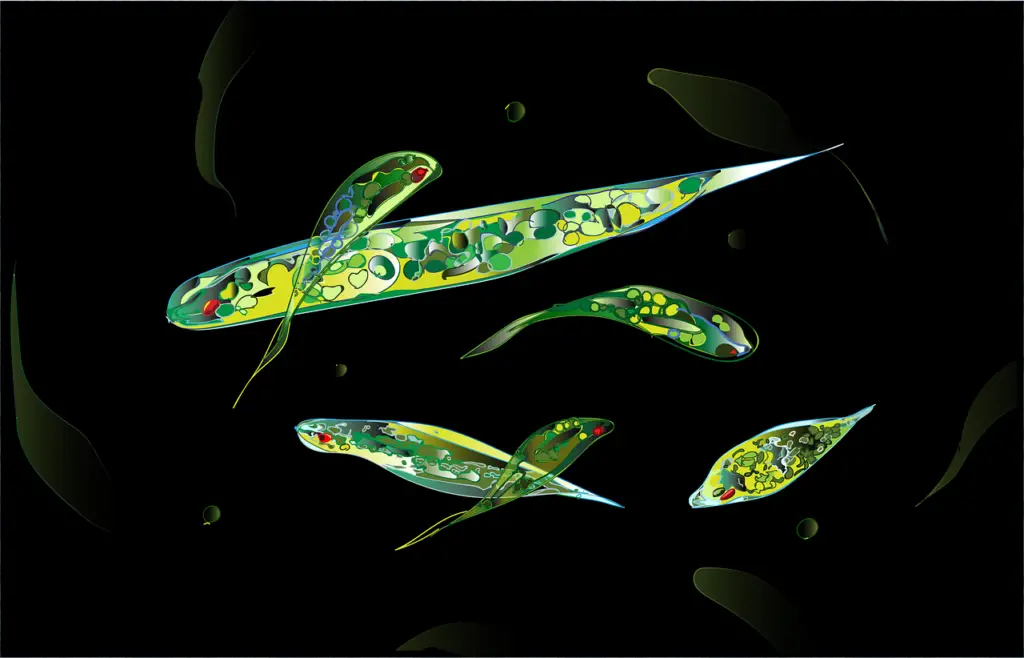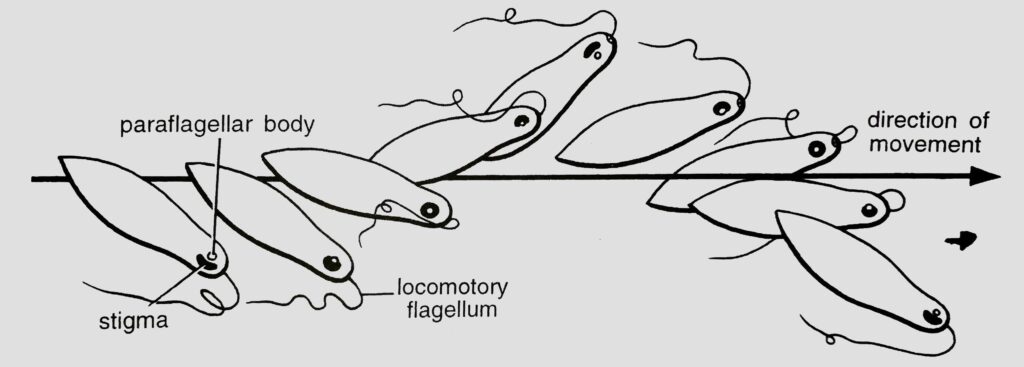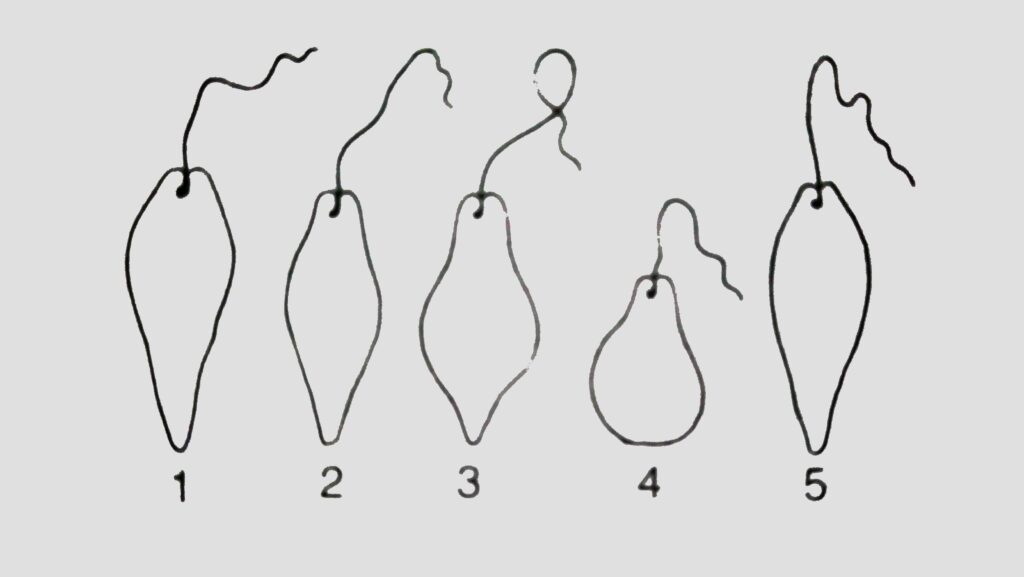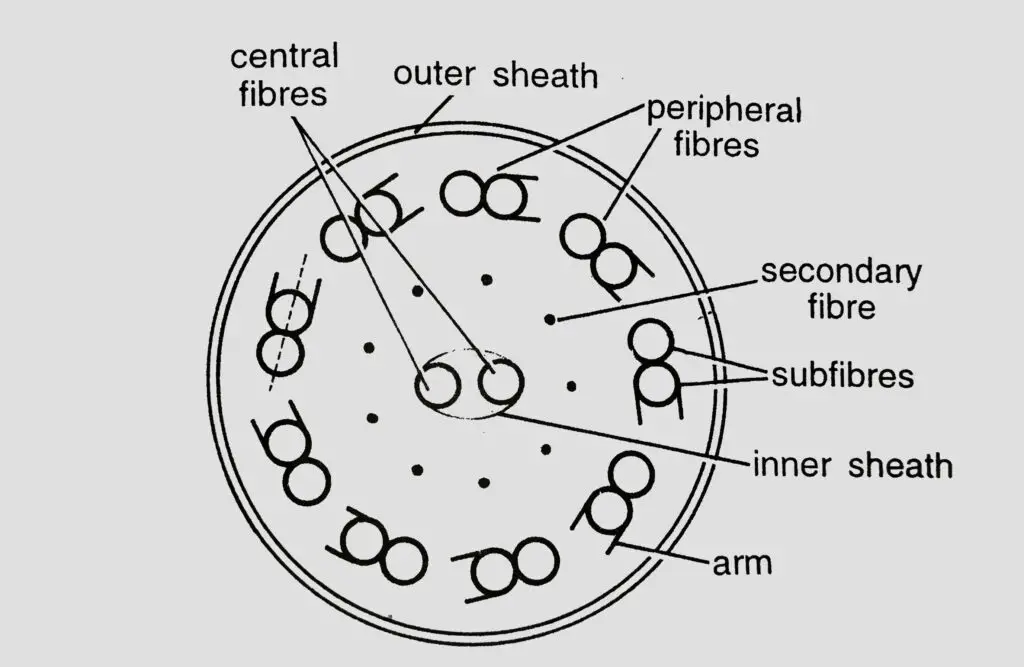How does Euglena move? (Locomotion & Movement in Euglena)
Euglena typically moves by Flagellar Movement where the flagella show lateral movement creating forces parallelly and at right angles that move the body forward.
It also moves by means of creating wavelike contraction and expansion of the organism’s body from the anterior to the posterior end, thus enabling Euglena to move forward.
Euglena is a typical example of Mastigophora. In the systemic position, Euglena is included in Kingdom Protista, Phylum Protozoa, Subphylum Sarcomastigophora, and Superclass Mastogophora (Flagellata).
Euglena is included in the list of a large number of small protozoans characterized by an elongated cell which usually is 15–500 micrometres in size.
These are a large number of small protozoans that move with the help of one or more flagella and are so included in Superclass Mastogophora (Flagellata).
Euglena is plant-like having chlorophyll bearing plastids and animal-like having no such plastids.

Euglena performs two different kinds of movements
- Flagellar Movement: By use of flagella to turn and twist in the water
- Euglenoid Movement: By use of pellicle to produce peristaltic movement
1. Flagellar Movement

Here in this type of movement, Euglena uses flagella to create a propulsion mechanism just like a propeller of boat to move the body forward in the water.
A euglena moves by whipping, twisting, turning its flagellum around like that of a propeller.
The locomotory flagellum is equal to the length of the Euglenoid’s body and it highly helps it to swim freely in water.
In Euglena, the Flagellum lies in the anterior end towards the side bearing the stigma.
This flagellum undergoes spiral undulations and beatings creating water waves, that are transmitted from the base to the tip moving the body forward in the water.
The flagellum undulates or beats at the rate of about 12-13 beats per second. And, this beating of the flagellum creates water waves that drive the water backward and induces the body to move forward.
The flagellum also undergoes a series of lateral movements and in doing so, the pressure is exerted on the water at right angles to its surface.
These lateral movements create two types of forces that exert pressure, one directed parallelly, and the other at right angles, to the main axis of the body.
The parallel force will drive the animal forward and the force acting at right angles would rotate the animal on its own axis.
It has been calculated that Euglena rotates at the rate of one turn per second.
Thus, due to the Flagellar movement, the Euglena’s body not only moves forward but also rotates on its axis.
And, when the flagellum beats over and over, the body also revolves in circles or gyrates.
Note that forward movement, rotational movement, and revolutionary movement are three different types of movement of the Euglenoid body caused by the locomotory Flagellum.
2. Euglenoid Movement

The Euglenoid movement is inspired by the process of metaboly, which is actually the biological ability of some cells, especially protozoans, to alter their shape and then come to their real shape just like an elastic rubber band.
This type of movement is usually possible due to the presence of Pellicle on the surface of their body. This pellicle causes peristaltic movements due to its flexibility and contractibility.
Here, the peristaltic movements or the very peculiar slow wriggling movements cause the formation of the peristaltic waves of contraction and expansion of the pellicle layers.
These waves pass over the entire body from the anterior to the posterior end and the animal moves forward.
As the peristaltic waves start forming and while it passes through the body, it causes the body to become shorter and wider first at the anterior end, and then in the middle, and later at the posterior end.
Due to this, the pellicular strips bend and move against one another. It is like one strip sliding in the groove of the other.
The sliding of the pellicle strips in the grooves is lubricated by the secretion of underlying muciferous bodies.
This resultedly creates elasticity and this elastic force tends the body to move forward. Thus, causing Euglenoid movement by means of the peristaltic movement activities of the pellicle.
Euglena has a stiff pellicle outside their cell membrane. This helps them keep their shape and structure intake while giving the body its flexibility and elasticity.
And, some Euglena can be observed scrunching up and moving in an inchworm type fashion using the pellicle.
This pellicle is a very important body part of the Euglena. Without the presence of this, the Euglenoid movement wouldn’t have been possible.
Structure of Locomotory flagellum that helps in movement

1. There is only one locomotory flagellum at the anterior end of the Euglena, and it’s almost equal to the length of the Euglena.
2. This flagellum originates from blepharoplast which lies at the base of the reservoir in the anterior end of the body.
3. It is made up of an axial elastic filament or axoneme, covered by a protoplasmic sheath.
4. This flagellum consists of 2 central fibres (enclosed in an inner membranous sheath), and 9 peripheral fibres in the periphery of the flagellum.
5. Each central fibres are single (made of one fibre each) and the peripheral fibres are paired (made of two sub-fibres each).
6. The 9 peripheral fibres bear a double-row arms each, all pointing in the same direction.
7. In the space between the peripheral and central fibres lie 9 secondary fibres.
8. This whole structure of the flagellum is continuous from the base of the flagellum to the tip while being enveloped by the outer sheath which is continuous with the plasma membrane.
Energy for the movement of flagellum in Euglena
The movement of flagellum involves the continuous contraction of its 9 peripheral fibres.
Their position inside the flagellum is just perfect for undulating actions as they could exert bending around the flagellar axis.
Thus, not only causing forward movement of the body but also rotation and revolution of the body as well, all in alignment to the flagellar and the body axis.
The energy for the contractile action of the fibres and so the flagellum is all provided by ATP (Adenosine Triphosphate- C10H16N5O13P3) formed in the mitochondria cell organelle of the Euglena.
The photosynthetic organism Euglena has the ATP synthase enzyme complex that highly interacts with the fatty acid molecules in the mitochondrial inner membrane, creating a curvature that is required to produce ATP more efficiently.
The mitochondria of Euglena are present inside the blepharoplasts situated at the anterior end of the body.
